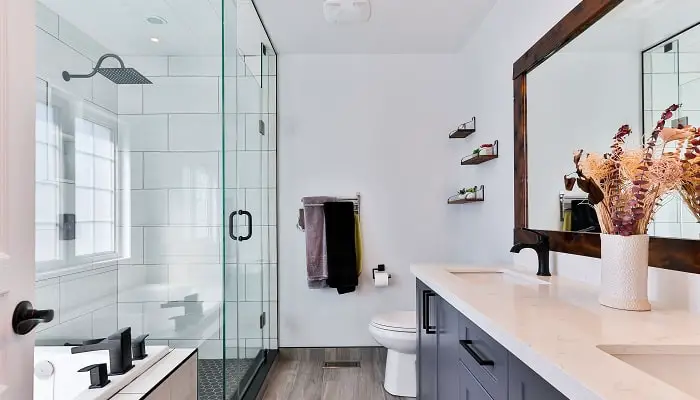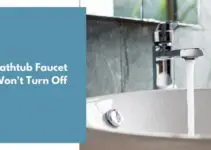It’s relatively simple to waterproof drywall if you know how to do it. That’s why we wrote this article. You will find inside the five best methods to waterproof drywall and answers to the most important questions.
For example, one way to waterproof your drywall is to use water-based urethane to cover all sides and edges of the drywall before the installation, making it waterproof.
Other than using a water-based urethane, there are more ways on how you can waterproof drywall in a shower. Get more ideas on what works for you. Read on!
Contents
- 1 What Can I Use to Waterproof Drywall?
- 2 How Do You Seal Shower Drywall?
- 3 Can You Use Regular Drywall in a Shower?
- 4 Can You Use Moisture-Resistant Drywall in the Shower?
- 5 How Do You Fix Water Damaged Drywall in the Shower?
- 6 How Do You Waterproof Drywall Above a Shower?
- 7 What Happens if You Don’t Waterproof Drywall in Your Shower?
- 8 Summary
- 9 Resources
What Can I Use to Waterproof Drywall?
It absolutely makes sense to waterproof drywall in a shower, but not everyone does this. So many people have been asking this question: “Do I really need to waterproof the drywall in my shower?” Simply stated, waterproofing may be of help in controlling moisture so the drywall will not be damaged.
The drywall is a construction material that is used for the ceilings and walls. One of its most important features is to provide fire resistance to the frame of houses, which is indispensable, especially during fire emergencies. But the major setback with the drywall is that it is not water-resistant. Hence, the question is posed on how to waterproof it.
Here is a list of materials you can use to make your drywall in your shower water-resistant:
Paint
Paint has been one of the first resorts of so many homeowners these days in waterproofing their drywall in a shower. You might get caught up in the same trend if you opted to listen to a neighbor’s opinion instead of doing your research. This is not at all false though, since there are high-quality paints out there that can aid in making your shower waterproof.
Our recommendation is RUST-OLEUM 5024 Watertite Latex Qt.
Pros: Paint indeed is inexpensive, and you can find it in any hardware. But be sure to remember one important thing, and that is to ask the representatives in the store what available paint is most water-resistant.
Cons: Using paint is more of a quick fix than a permanent solution. It may be the fastest and easiest way to solve your waterproofing concern, but the paint wears off quickly in the bathroom – especially if we’re talking about a deliberate amount of moisture that will surely seep through the drywall through the paint.
Waterproof membrane
It may sound odd to use this material for waterproofing your drywall. Still, it is one of the most reliable. A waterproof membrane usually looks like a sheet, but it is made of plastic and uses a thin coating of tile mortar for it to stick on the walls.
We can recommend you XFasten Fiberglass Waterproofing Anti-Fracture Membrane Fabric Tape.
Pros: Waterproof membrane may work out fine for almost everyone. It seals better than paint for sure. One bonus you might enjoy is the soundproof feature for some brands of sheet membrane.
Cons: If you are tight on the budget, this is probably the biggest downside to sheet membrane waterproofing. It is expensive and more challenging to install than most water repellent materials. Also, having a professional to aid in the installment is a must (to steer clear of disaster).
Polyurethane liquid membrane
Polyurethane is a plastic material, so it is no surprise that it is reliable when it comes to waterproofing. It is an all-around material, too, due to its flexibility.
We can recommend you USG DUROCK Brand Liquid Waterproofing Membrane.
Pros: It has astounding waterproofing components, and it can fill in the cracks on the drywall. Not only does it make the surface waterproof, but it also makes it tougher than before it is installed. Also, water vapor, which over time, destroys other waterproofing materials, is no match for polyurethane.
Cons: But there will always be that other side of the coin. Polyurethane is a powerful chemical that could be harmful if contacted to your skin, so being extra careful will help. Another thing is that you may have to spend extra bucks on this material.
Bituminous coating
Bituminous coating is formed from bitumen-based substances. Bitumen is a kind of crude oil that is blackish in color. It is commonly known in many countries as asphalt.
Pros: Bitumen is known for its flexibility. Also, it is durable. Compared to the other water-resisting materials, it is also less expensive.
Cons: It should not be subjected to heat. Its durability is tremendously reduced when exposed to sunlight, so it is a big no-no if your shower’s location is situated where the sunlight is.
Cement
The cement-based waterproofing method is typically used in domestic areas. Aside from being a binding agent in construction, cement is also useful for waterproofing.
We can recommend you Damtite 07121 Gray Waterproofing Hydraulic Cement.
Pros: The cement is easy to find, and it is cheap. It also toughens up the surface when applied. Another thing is that it is easy to apply.
Cons: Unlike the other waterproofing materials, it is not that flexible. It chips away when subjected to extreme heat or extreme cold.
If you need a more visual guide, you can take a look at the following video:
How Do You Seal Shower Drywall?
There are different types of drywall. Here are simple steps to get your water-resistant drywall installed:
Step 1: Knowing your measurements before you begin is vital. Make sure you measure correctly how much space you want to be sealed with the drywall and how much of the drywall you need.
Step 2: Once you finish putting down measurements and cutting the drywall in its desired form, proceed to attach it to the wall studs. You can do this using nails or drywall mud.
Step 3: Smooth out the seams using the drywall mud again with the stiff steel blade.
Step 4: Allow the drywall compound to settle and dry for a couple of days.
Can You Use Regular Drywall in a Shower?
As a last resort, yes, you can use regular drywall in a shower but only for the tilings. It is wiser to use water-resistant drywall to prevent water leaks or water seeping through the tilings. When using regular drywall in a shower, reinforcement materials may also be installed.
Can You Use Moisture-Resistant Drywall in the Shower?
Simply speaking, yes. But there are better options. Moisture-resistant drywall, also known as green board drywall, is a material layered with plaster that helps it withhold water, but it is not waterproof, making it less effective.
The good news, though, is that materials that are sure to be waterproof are available. There are products that are more durable that you can use. Here are some suggestions we have for you.
Cement boards
Cement boards are durable. It can totally resist pressure or impact. Compared to green board drywall, cement boards are typically smaller, making them more suitable for areas with limited space like showers.
Blue board drywall
Blue board drywall is totally in trend these days. Like the green board drywall, it is also water-resistant and doesn’t collect molds. You won’t have to be bothered with it getting unpleasantly sticky after being in a moist space for too long.
How Do You Fix Water Damaged Drywall in the Shower?
Damaged drywall can cause a lot of stress and can be time-consuming to fix. Since drywall in showers is absorbent to moisture and water, it can collect a lot of molds. According to experts, these are highly recommended steps to fix the problem quickly.
1. Find Out Where The Damage Is Coming From
Different circumstances in a variety of showers can affect the condition of the drywall. It is important that you know what is causing the damage for you to be able to determine the most appropriate solution to the problem. Whether to fix or reinforce your drywall.
2. Remove Damaged Material
You can detach the drywall quite easily with a drywall knife by tracing its edges. Drywall can instantly become soggy when wet, so it is necessary to remove it. You will not have any use for the drywall once it is out of shape.
3. Replace The Damaged Drywall
Prepare the drywall by measuring it to the exact size that needs to be replaced. Attach the drywall to the water-studs of the desired space. Finally, apply the drywall mud in the corners and coat it with paint to blend its color with the rest of the wall.
How Do You Waterproof Drywall Above a Shower?
Waterproofing drywall above a shower is as doable as waterproofing it anywhere. According to experts, there are countless ways to make your drywall more resistant to water. This includes using moisture-resistant paint to coat it a number of times, waterproof membrane, polyurethane liquid membrane, bituminous coating, and cement.
What Happens if You Don’t Waterproof Drywall in Your Shower?
Moisture can penetrate into regular drywall, especially when not waterproofed. This may cause it to accumulate mold or become deformed in its shape. It may expand, become less durable, sometimes fall off, and at worst-case scenarios, make the wall leak.
Summary
Overall, drywalls have been useful throughout the years, but they would always do better with waterproofing. There are so many materials to choose from in order to ensure that the drywall in your shower is watertight. The best part is that you can choose whether to install the materials by yourself or with the help of a professional.
Getting things done around the house may take a lot of time and effort on your part. But every sweat will be worth it. Just be sure to follow this guide.
Resources
Photo by Sidekix Media on Unsplash




